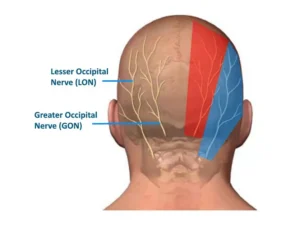
Pain in the back of the head and neck can be frustrating, exhausting, and surprisingly complex. Two common causes of this pain are occipital neuralgia and cervicogenic headaches. While they affect the same general region, they differ in their origins, symptoms, and treatments. At Red Butte Pain Solutions, we help patients find relief by accurately diagnosing the cause and offering tailored treatment plans.
What Is Occipital Neuralgia?
Occipital neuralgia is a nerve-related condition. It occurs when one or more of the occipital nerves—the greater, lesser, or third—become irritated or compressed. These nerves travel from the upper neck to the back of the scalp.

Symptoms of Occipital Neuralgia
- Sharp, stabbing, or electric-like pain at the back of the head or upper neck
- Pain that can radiate to the scalp, behind the eyes, or toward the forehead
- Increased sensitivity to touch or pressure along the scalp
- Episodes may be spontaneous or triggered by simple actions like brushing your hair or turning your head
Many patients describe these episodes as feeling like being stabbed in the skull with a sharp object—what some call an “ice pick headache.” If that sounds familiar, our blog post on occipital headaches and ice pick-like pain explores this symptom in more detail.
A common and effective treatment for occipital neuralgia is the use of occipital nerve blocks, which can provide both rapid relief and diagnostic clarity.
What Are Cervicogenic Headaches?
Cervicogenic headaches are caused by issues in the neck, particularly involving the joints, discs, or muscles. One of the most common causes is cervical facet arthropathy, where the small joints of the cervical spine become worn down and inflamed.
Two specific facet joints often contribute to cervicogenic headaches: the C2-C3 and C3-C4 joints. Pain from the C2-C3 joint frequently radiates to the upper neck and behind the ear, while C3-C4 facet joint pain symptoms can cause aching or pressure in the back of the head and upper neck. Both joints are common pain generators in people with arthritis, prior injuries, or chronic poor posture.

Symptoms of Cervicogenic Headaches
- Dull, aching pain that starts in the neck and radiates to the back of the head
- Usually one-sided pain, but may spread across the scalp or to the temples
- Increased pain with head movement or prolonged sitting
- Neck stiffness and limited range of motion
These headaches are commonly seen in people with desk jobs, whiplash injuries, or age-related degeneration. You can learn more about the causes and treatment options by visiting our Cervical Facet Arthropathy page.
While we don’t offer in-house physical therapy, we partner with top physical therapy groups across Chandler, Mesa, Gilbert, Ahwatukee, and the surrounding areas to make sure our patients receive the highest-quality care possible.
Diagnosing the Cause of Your Back of Head and Neck Pain
We start with a detailed history and physical exam to distinguish between occipital neuralgia and cervicogenic headaches. Imaging may help in certain cases. Diagnostic injections—such as occipital nerve blocks or cervical medial branch blocks—can help confirm the source of pain.
Treatment Options That Work
Occipital Nerve Blocks
For occipital neuralgia, we often recommend occipital nerve blocks. These involve a quick injection of local anesthetic—and sometimes corticosteroids—near the occipital nerves. They often provide fast relief and help guide next steps. For longer-lasting relief, botulinum toxin injections may be considered.
Cervical Medial Branch Blocks and Ablation
For cervicogenic headaches due to arthritic facet joints, we target the tiny nerves that supply these joints. We first perform a medial branch block to confirm the source of pain. If the block is successful, we may proceed with radiofrequency ablation of the cervical medial branches. This treatment provides longer-lasting relief—often several months or more.
Medications
- Occipital neuralgia: Medications like gabapentin, pregabalin, or amitriptyline help calm irritated nerves.
- Cervicogenic headaches: NSAIDs and muscle relaxants are commonly used to reduce inflammation and ease muscle tightness.
Combining Therapies for Better Outcomes
Occipital nerve blocks may help patients return to daily activities faster. Cervical medial branch ablation can bring long-term relief for those with facet joint arthritis. By combining the right therapies—and coordinating with local physical therapy providers when needed—we aim to help you reclaim your comfort and quality of life.
When to Seek Help
If you’re living with back of head and neck pain, don’t wait. Whether it feels like a stabbing nerve pain or a dull, aching pressure, we’ll help you find the cause and provide real relief.
Call to Action
If you’re experiencing back of head and neck pain in Tempe, Chandler, Ahwatukee, Mesa, Gilbert, Maricopa, Casa Grande, or Sun Lakes, Red Butte Pain Solutions is here to help. Our team specializes in accurate diagnosis and minimally invasive treatments that work.
📞 Call us today at 602-633-4334 or
🔗 Schedule now
